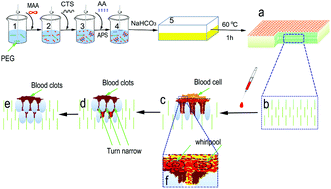A porous sodium polyacrylate-grafted chitosan xerogel for severe hemorrhage control synthesized from one-pot reaction†
Abstract
Controlling severe hemorrhages remains a challenge. Successful hemorrhage control depends on the speed and quality of blood clot formation. Fast deprivation of water from blood leads to the concentration of blood cells and coagulation factors and thus triggers blood clot formation. This inspired us to develop a new hemostatic material. In this study, we grafted sodium polyacrylate (SPA) onto the backbone of chitosan (CTS) and crosslinked with methacrylic anhydride-modified polyethylene glycol (MAAPEG) to provide a flexible and elastic inter-chain connection between SPA and CTS chains in the presence of a blowing agent to achieve a porous structure. By a simple one-pot reaction, we fabricated a soft, elastic porous xerogel sponge that could reach maximum water absorbency of 180 in less than 200 seconds. This SPA-co-chitosan xerogel sponge demonstrated superior hemostatic properties in thromboelastography (TEG®) test and in a rabbit lethal extremity arterial bleeding model as compared to zeolite granules, kaolin gauze, and chitosan granules. Furthermore, this hemostat worked as a whole to transfer external pressure to the bleeding area and was adhesive to wet wound tissue to seal the bleeding site. In general, the SPA-co-CTS sponge demonstrates a fast and powerful hemostatic effect both in vitro and in vivo, which is superior over the existing commercial products. It might be a promising first-aid device for severe hemorrhage control.

- This article is part of the themed collection: 2017 Journal of Materials Chemistry B HOT Papers


 Please wait while we load your content...
Please wait while we load your content...